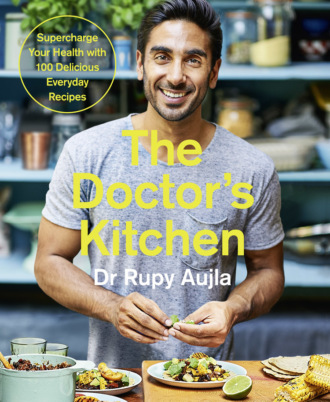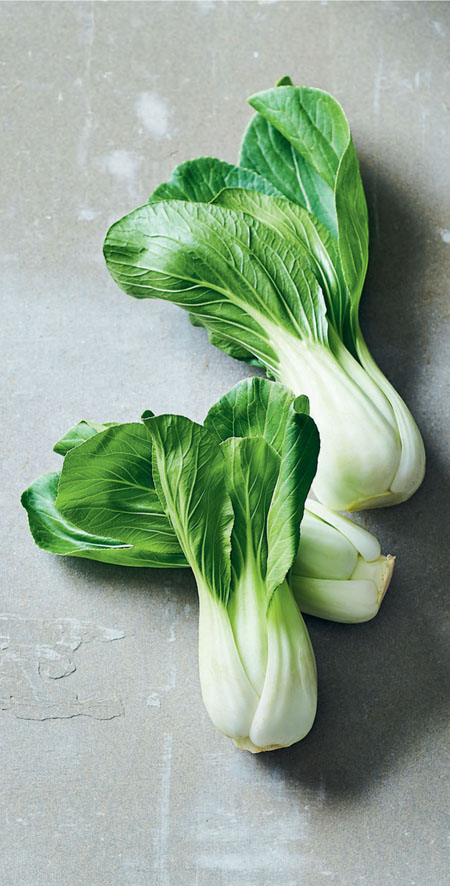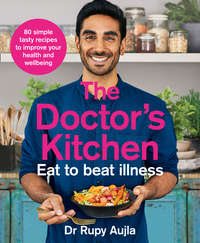
Полная версия
The Doctor’s Kitchen: Supercharge your health with 100 delicious everyday recipes
What has this got to do with food? Everything.
Micronutrition and the timing of when we eat as can alter our gene expression.71,72 Our food is constantly communicating with our DNA.
This area of research is adding yet another layer of complexity to the scientific study of why and how what we eat affects our health. There is a wealth of information available on this subject far beyond the remit of this cookbook! If you are interested, I have extra information on my website, www.thedoctorskitchen.com, including links to reading materials on subjects such as nutrigenomics, nutrigenetics and epigenetics.
Despite its complexity, I included this section because I want you to appreciate the incredible effect food has on our longevity. I want to share some insight into the fascinating studies that have framed my understanding of how food has positive effects on our bodies.73,74 It explains why I try to weave certain ingredients into my dishes that tick the boxes for both flavour and function. By including these delicious ingredients in our diet we can potentially affect our genetic functioning for the better.75 Today, we can start this colourful and enjoyable journey toward good health.
I hope this motivates and inspires you to look at adapting your diet as a powerful, positive intervention. On a personal note, learning more about this field of study encouraged me to increase my intake of certain foods and explore lifestyle practices that may improve the functioning of my body. I believe that if we focus on wellness and introducing health-promoting foods and activities, the body has incredible potential to look after itself, as has been my personal experience. It’s so empowering to know that despite our genes, we have the ability to steer the direction of our destiny using lifestyle.71,76 Food is integral to this process. It is the cornerstone of healthcare and one of the biggest joys in life.
So, what do we need to eat to improve our gene functioning? In a very general sense, ensuring we have a variety of micronutrients (vitamins and minerals) is the best way to ensure proper functioning of our cells and expression of our genes. Our understanding is still basic and there’s a long road ahead, but there are some key diet and lifestyle measures that we can all incorporate to ensure the correct functioning of our bodies. The good news is, these micronutrient-dense foods are tasty, cheap and easy to cook with. Here are some examples of foods I encourage my patients to eat regularly, and a snapshot of the science that explains why.
+ A WORD OF WARNING
Already, there are tools you can buy that can read your genetic profile and claim to give you tailored nutrition advice online, but I suggest treating these with caution. Simply looking at genetic profiling in isolation is a narrow perspective to take and it’s not as simple as ‘eating to beat your genes’. Health outcomes are the result of a complex interplay of food, gut health, environmental stressors and many other variables. The future of medicine is definitely personal77 and I’m certain it will soon become the norm to have these tests, but they have to be taken in the context of the individual’s circumstances. We are sophisticated machines with multiple pathways beyond our genes that we need to consider, but it doesn’t stop me from getting excited about the future application of these tools for practitioners.
Greens for your genes
Romanesco cauliflower, cabbages of all kinds, pak choy, rocket leaves, broccoli, broccoli sprouts, Brussels sprouts, cavolo nero, kale, chard…
Everyone knows that these greens are ‘good for us’. It has been drilled into our heads since childhood. But, apart from fibre and vitamins, greens have a wealth of other properties. Cruciferous vegetables (also known as brassicas), in particular, are known for their sulforaphane content. Sulforaphane is a plant chemical currently being researched for its ability to stabilise cells and protect against cancer. It also appears to impact a master regulator of genes involved in reducing cancer activity.78
But this is merely one of the hundreds of compounds involved in the mechanism of why greens are ‘good for us’. Cauliflower, broccoli, broccoli sprouts and rocket leaves all contain sulforaphane, plus a whole lot more that hasn’t yet been fully investigated. And these vegetables don’t just contain novel chemicals; they are also full of micronutrients like magnesium and folate which are vital for repairing and producing DNA.79,80
One of the key features of the influential Dean Ornish study73 that showed lifestyle changes could promote genes that fight cancer, was a plant-focused diet high in cruciferous vegetables. Best of all, these ingredients can taste wonderful with the right spices, herbs and cooking techniques to moderate their naturally bitter taste. You’ll want to have these affordable foods every day.
Spice your DNA
Herbs and spices are what make cooking and eating so pleasurable. In Middle Eastern cuisines, they often serve fresh herbs alongside tagines and stews to complement the rich, earthy flavours. Vietnamese food is commonly presented with a side plate brimming with mint leaves and whole coriander stems. Our Indian version of a salad (see here) includes sliced red onion, fresh lemons and, of course, raw chilli. As a child, I would watch in awe as my father ate small bites of whole green chilli with his meals. I still haven’t quite acquired the taste for this level of heat!
Fresh leaves are more than just sharp flavour notes to accompany a meal. Simple herbs like parsley, for example, contain plant chemicals called flavones.81 These are known to promote the activity of genes that are responsible for suppressing inflammation,82,83 a key feature in conditions like cancer and diabetes.
And it’s not just parsley … rosemary, turmeric, ginger, oregano, onion and garlic are also abundant with health-promoting chemicals including epigalletins, quercetin, luteolin and others with equally long and confusing names.84 To cover just our limited knowledge of all these compounds and their potential uses would fill volumes of books.
I don’t want to steer you in the direction of only eating particular foods to alter your gene activity – I simply want you to appreciate the immense power of everyday ingredients. Herbs and spices are very much part of that line-up. So, when you look at my recipes, notice how highly flavoured and spiced they are. There is a method behind these flavour-packed dishes.
Colour your plate
I’m passionate about colours. They truly represent the complexity and beauty of food. Beyond their spectacular visual display and abundance of antioxidants, colourful foods are exceptionally important for us for their effects on our genes.75 Plant chemicals (also called phytochemicals and phytonutrients) are responsible for these beautiful pigments and are usually found concentrated in the skins of fruits and vegetables.
We know that reducing inflammation is hugely important when it comes to longevity and reducing the risk of diseases ranging from dementia to depression.85 An example of a plant chemical that gives food a vibrant, red colour is anthocyanin.86 You’ll find this in everything from beetroot and wild berries to red onion (not just pomegranate juice and acai powder!). Anthocyanins are known to activate the gene responsible for heightening antioxidant activity which can prevent against cancer.87 It is an incredible ingredient, but one of literally thousands that could be just as impressive.
Rather than using a reductionist approach to the science that concentrates on the benefits of singular compounds, I implore you to remember that all foods have a number of chemicals in varying amounts that are wonderful.88 Variety and nutrient density is the goal here. Don’t focus too much on exact lists of ingredients and their chemical attributes. Choose vibrant colours and foods that you and your family will enjoy to reap the benefits of nature’s gifts. And remember … don’t throw away the skins!
The power of your microbiome
The microbiome is a feature of our health that we’ve already visited (see here). It is the name we give to the trillions of microbes (mostly bacteria) that reside all over our body but mainly in the gut. Because of the sheer number of microbes in this population, your microbiome consists of over 100 times more genetic material than your own.89 This population has immense impact on the health of your body and mind because the microbiome genetic code is quite literally communicating and interacting with your own.90,91 The scientific community has only started appreciating this information over the last 20 years. The most exciting feature is that although we cannot change our own genetic information, the genes and health of our microbial population can be altered by environment and that affects the expression of our DNA.92
This may all sound quite fantastical – the fact that our destiny is in our hands. We are quite far away from precision treatments that alter the microbiome for specific health outcomes, but science tells us that if we eat and live according to principles that help our microbiome population thrive, we live healthier lives and are less likely to suffer disease. One of the probable reasons for this is because the microbiome has an ability to positively affect the expression of our DNA. Nurturing your gut health (see here) could prove vital in disease prevention and treatment.
Lifestyle for genes
• Sleep is integral to health. It’s also very impactful on our microbiome and our circadian rhythms that affect our biology and gene expression.93 Melatonin is a hormone (produced during adequate sleep) which activates and regulates hundreds of genes involved in repair, antioxidant function and, you guessed it, inflammation.94,95 Sleep does far more than just let your muscles repair and brain recuperate; it’s essential for protecting you against disease. So, practise good sleep hygiene: try not to eat or use electronic stimuli two hours before bed, and sleep your way to health.

• Fasting is a practice made popular by diets like 5:2 and proponents of ‘ancestral eating’ that aim to mimic the lifestyles of former hunter-gatherer populations. While I take issue with blindly following a standard diet, fasting is a component of these regimes that may have some legs. Incorporating a fasting practice into your eating habits has been shown to improve the expression of genes that are responsible for removing oxidants that cause inflammation and turning on genes that fight cancer cells.96,97 But fasting doesn’t need to be a tedious feat where you remove all sources of energy for a 24-hour period. I’m a fan of defining your eating period to 10–11 hours per day. For example, if you were to eat breakfast at 8am, try not to eat dinner later than 7pm. Getting into a routine where you have the same ‘defined eating period’ on a daily basis may have benefits by heightening the expression of genes that control sugar and lead to greater longevity.98,99,97 Most of the studies also found that participants lost weight and this has obviously generated a lot of attention, but in my opinion losing weight isn’t necessarily always the goal. If we focus on introducing health-promoting habits and wonderful nutrition I am certain you will lose weight, but more importantly it will be enjoyable, safer and much better for your overall health. Wellness is the goal rather than a desired number on a set of scales.
• Mindfulness doesn’t have to be cliché. My father grew up on a farm. He would wake up before dawn every single day and in his sleepy state make the short walk to the farm where he would duly milk the cows for the family’s breakfast and butter-churning routine. This could be considered an example of mindfulness. An activity which removes thought and reason, and incorporates routine. Where the mind is quiet, restful and unstimulated.
Buddhists sweep. Beach bums surf. Commuters listen to smartphone apps. However you decide to practise it, mindfulness has never been so important as it is in now, in today’s world of excessive electronic use and hyperactivity.
We live in a perpetual state of anxiety, provoked by constant stimuli, and I believe meditation is key. One of the most impressive research studies I have come across was a small experiment looking at a group of people taught to meditate over a three-week period. Using a specific gene marker to measure the inevitable ageing process, they discovered that the meditation had improved the marker that was expected to naturally worsen.100,101 Meditation has been hypothesised to have a literal anti-ageing effect.102 If an intervention can alter gene activity to that extent, it has a place as a ‘medicine’ in my opinion. So, decide on your meditative strategy and practise it for at least 10–20 minutes each day. You should find it has a calming effect on your mood, even if we can’t conclusively prove its effect on wrinkles.
We live in a perpetual state of anxiety, provoked by constant stimuli, and I believe meditation is key.
Diet choice fatigue

I’ll let you into a secret you probably already know by now: there is no such thing as a ‘perfect diet’.
We are all unique as a result of our cultural backgrounds, genetic variations and even gut microbe populations. Our physical attributes are the sum of so many variables, it is unfathomable to think that any one regimen would be suitable for an entire population.
Our diets are fluid, ever-changing interactions that involve the environment and even our life cycle. The food we eat is dictated by geography, convenience and personal choices. Our nutritional needs are determined by age, hormone profile and emotional state, and that’s before we even start considering medical conditions. We are complicated beings. Forcing ourselves to rigidly stick to a list of foods that are labelled ‘good’ or ‘bad’ will never reflect the intricacies of our requirements.
My goal is for you to enjoy food and appreciate the phenomenal effects it can have on your body, your mental outlook and overall health. I’m not here to scaremonger you or belittle any successes you may have had with previous experiences of diets; if you have used one of these in the past and felt better, that’s fantastic! As long as you feel healthy, it fits into your lifestyle, and it doesn’t lead to a nutritional deficiency or personal risk of disease, you’re doing a great job. I’m not here to warn you off a way of eating that works for you and I’m very open-minded to the success of certain diets for different people. As a doctor, I just want to make sure you’re safe and healthy.
If you’re new to this world, I want you to understand the importance of individuality. I would rather empower you to create a unique way of eating that caters for your requirements, than suggest you follow a ‘one-size-fits-all’ approach.
Eating is a lifestyle, not an uncompromising ‘diet’. It’s a personal and experimental process that needs adapting as you and your environment change. This book, or any other book for that matter, will not contain the answer to everyone’s dietary requirements. But don’t despair! I’ve included principles of eating here that I think are applicable to most people, then the tweaking of elements really depends on you. Seek appropriate advice and get a second opinion if you have concerns about a specific medical condition.
Most diets out there promote a way of eating that is generally better than the typical Western diet of refined carbohydrates and a lack of fibre and micronutrients. So, no wonder there are so many success stories with a lot of them! This doesn’t necessarily validate these diets as a way of eating for all of us. But, it’s likely that you’ll incorporate elements and principles from a variety of diets to create the perfect way of eating for you. Because I get asked about these in clinic all the time, I’ve decided to give you my opinion on the most popular diets around: the good, the bad and the science that doesn’t always stack up.
Just cut the carbs!
+ Paleo, Low-carb high-fat, Atkins, South Beach, Ketogenic I know proponents of each of these diets will argue that these shouldn’t be grouped together because there are slight variations between each, but for simplicity’s sake, I have. Patients don’t appear to differentiate between them and lately I’ve been hearing the same line in my surgery: ‘So, Doctor, I’ve decided to cut out carbs. That’s good, isn’t it?’ Well, not necessarily.
The principles of Paleo, South Beach and Atkins are quite similar. They revolve around reducing your intake of carbohydrate and replacing it with varying proportions of protein and fats, with ‘low-carb high-fat’ (aka LCHF) and Ketogenic diets being the most excessive in terms of fat consumption. They’ve been reported in clinical studies to improve markers of diabetes103,104 and famously autoimmune disease105 in a number of protocols. The most exciting promise for Ketogenic diets is in treating childhood epilepsy and chronic pain.106,107
I think these types of diets do have a place for certain people looking to re-sensitise themselves to insulin after a longstanding over-indulgence in refined carbohydrates and sugar. There is small-scale evidence to show its potential in improving diabetes, insulin sensitivity108 and symptoms of PCOS.109,110
However, there is some evidence pointing toward high protein intake being similarly harmful as high carbohydrate intake, which is the trap a lot of people fall into when following these diets.111
And let’s not forget the side effects that include: constipation, halitosis, nausea, renal stones, osteoporosis and a potentially increased risk of bowel cancer (among many others).
A lot of people can’t maintain the diet for these reasons, and when they return to eating carbohydrate there appears to be a trend toward regaining all the weight they had lost with potentially worse outcomes and health risks than before they began.

On balance, long-term evidence to advocate these diets is lacking. Essentially, it’s a temporary fix. I appreciate the potential therapeutic value of these diets as a short-term strategy, but personally, I think a diet concentrated on plant nutrition far outweighs one focused on meat. More research is needed to validate the claims of these diets that drastically remove beneficial carbohydrate sources, and the lack of fruit, vegetables and fibre is something that would concern me. We know fibre is essential for proper functioning of our digestive system: our microbes feed off these materials and lack of fibre puts us at risk of bowel cancer.112 For those reasons, I can’t condone low-carb lifestyles long-term, but I don’t doubt that some people have found them beneficial and they may have a role in clinical care.
SIRT diet
While I welcome excitement about foods that have the potential to impact our genetic make-up, the SIRT diet’s focus on a small list of foods impacting some genetic pathways detracts from how multifaceted and complicated human nutrition is. ‘SIRT’ genes are what this diet is named after and increasing the activity of these genes (and the proteins they code for) is thought to reduce inflammation, control blood sugar and has been linked to reducing cancer risk.113
Yes, parsley, dark chocolate and green tea all increase SIRT gene expression but they also contain catechins, luteolin and a host of micronutrients that are essential for processes in our body’s cells. As do lupini beans, cavolo nero, broccoli, coriander, chilli and a whole bunch of foods that don’t fit a particular list. I think it completely misses the point to focus on an exclusive group of ingredients, and it doesn’t encourage a healthy relationship with food. Every ingredient deserves a platform.
Our grocery aisles are lined with unbelievable health-promoting foods, our seasons provide constant variety and our multicultural society introduces spices and herbs from across the planet. As I alluded to in the previous section, we are merely scratching the surface when it comes to the importance of different interactions between ingredients and our genes. I could have quite easily picked out a few fruits, vegetables and spices affecting one of many inflammatory pathways and called it the ‘NRF2 diet’, or how about the ‘TNF diet’? The Telomere diet? Do these sound scientifically valid enough?
The interaction between food and our genetics is a fascinating field.114 But it is one layer of a multi-faceted process that I haven’t made the cavalier attempt of trying to explain in its entirety. It certainly cannot be explained with one set of genes. Don’t let yourselves be patronised. Our understanding of these pathways is minuscule at best115 … and don’t get me started on ‘juice cleanses’!
The interaction between food and our genetics is a fascinating field.
5:2 diet
The science used to formulate intermittent fasting diets like the 5:2 diet is impressive.116 There appear to be benefits of cyclical fasting,117,118 but our way of eating needs to be sustainable119 and more importantly, enjoyable. Who wants to endure restricting themselves on a weekly basis … for life? I am convinced that some people have found benefits from this practice,120 but if I were to tell the majority of patients I see in clinic to reduce their calories to 500 for two whole days, I know exactly where they’d be telling me to go!
And this brings me nicely to another topic. I don’t count calories. For the majority of people it’s a complete waste of time because it shifts the focus toward indiscriminate numbers on packets of food and away from what is actually important: the quality of food we introduce into our body. Clearly, a bag of sugar compared to an equal calorie content of spinach is going to have drastically different effects on our body. Calorie counting does not account for this difference. It focuses unnecessarily on a logic that was once thought to be scientifically accurate but is now shown to be flawed in many ways.
+ A NOTE ON CALORIES
The long-held idea that excessive calorie consumption leads to weight gain and reducing calories leads to weight loss is simply not accurate. Also, the metabolism of food is likely to differ from person to person depending on a host of factors such as their microbiome population, their genes, activity level, timing of meals and many other variables. A 200-calorie lunch isn’t necessarily ‘healthier’ than the 500-calorie one, and two identical calorie meals can have entirely different metabolic effects. The majority of people I see in clinic do not need to diligently measure and obsess about these numbers.
When we encourage concentrating on calories, or even the Glycaemic Index (GI) of foods, we lose sight of the bigger picture. People find themselves picking up ready-made desserts and putting down bananas. This is madness. There is a huge difference between the metabolic effect of packaged meals and a whole food. Diets that promote this are not educative and they serve to confuse rather than inspire, with dire consequences. Relax, cook as often as possible at home using whole ingredients, and put the calorie counters away.
Fasting, and the variations of fasting practices120, is an interesting area and warrants further research. But, what I think is potentially as effective and easier to incorporate into daily working life is the concept of defined eating periods.121 A time period during the day when you eat versus a period when you do not eat. Research also shows that the simple effort of ensuring you eat at regular times and within a 10–11-hour window can reduce your risk of diabetes and cardiovascular disease.122 It stabilises insulin release and leads to less fat around the organs (which is dangerous). It makes logical sense to me and a lot of my patients are easily able to slot this convenient ‘fasting’ practice into their eating habits that doesn’t require obsessive calorie counting or restriction.



